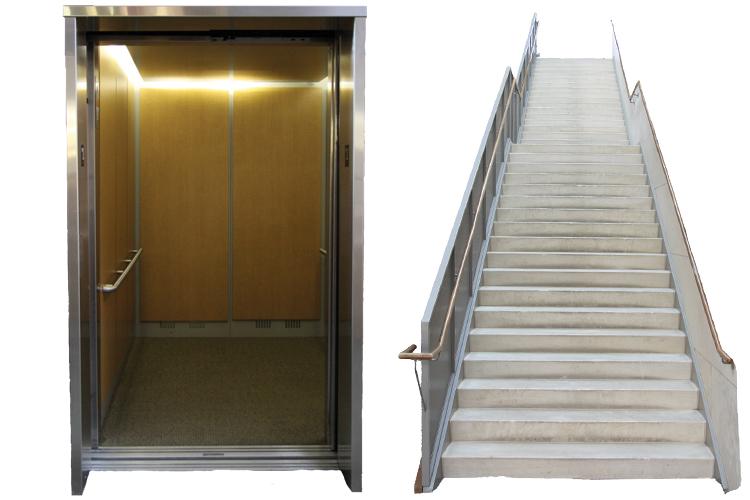Elevator
By Mary Orsak, Magazine Editor
Although no comprehensive history of the elevator exists to my knowledge, the first primitive elevators date back to the third century B.C., and since the Greek mathematician Archimedes designed the first known “elevator” (a mechanism that resembled a pulley more than the 102-story elevator in the Empire State Building), elevators have had a front seat to history.
For example, Louis XV installed a “flying chair” at Versailles in 1743 so that one of his mistresses could enter her private quarters on the third floor without arousing the opprobrium of the French court. Elevators have also provided moviegoers with some of Hollywood’s most iconic scenes (anyone remember “The Shining” trailer?). I can only imagine the myriad of important conversations that have occured in elevators and the history that has been made in these seven-by-six-foot steel boxes.
Although far less exciting than a forbidden royal romance, I, too, have my own elevator story.
As a member of the Rosenthal advisory, every morning at 9:50 I make the treacherous trek to the third floor of the Liza Lee Academic Research Center. After translating Vergil’s “Aeneid” word by word in AP Latin class, I cannot bare the thought of climbing the daunting marble staircase. Listening to Aeneas whine about the challenges of founding a new city is exercise enough.
Therefore, when I see an exhausted gaggle of advisees congregating outside the ARC elevator, I frantically flap my arms, shouting, “Hold the door! Wait for me!”
During these daily elevator rides, I have found a sense of belonging that I have never truly been able to replicate.
Elevators create a magic sense of intimacy. For 30 seconds, a group of strangers stand less than arm’s length apart and withdraw from reality. They enter a liminal space where only they exist, and in this isolation, a sense of camaraderie materializes. You cannot avoid uncomfortable eye contact or an accidental brushing of the hands. Instead, you embrace the absurdity that you are standing in a metal box accelerating against the force of gravity at speeds between five and 20 miles per hour.
In these moments, I divulge my greatest failures and share my most extraordinary successes with my fellow advisees. At times, we discuss the grave subjects of Winter Formal dresses and the Draconian nature of the Hockaday dress code. We giggle about the unfortunate times in which we have replied all to mass emails, and we comfort one another before a stressful test. We discuss the shame we feel when we catch sight of our advisor Ana Rosenthal speeding up the stairs.
I won’t try to lie and tell you that elevator rides are quicker and healthier than the stairs, and I know Mrs. Calhoun would prefer if I committed to my senior independent study goal of taking the stairs every day. But I cherish those moments in the elevator with my advisory.
Senior year is a tumultuous experience that brings new privileges, remarkable accomplishments, acceptances, rejections, nostalgia and immense fun. Sometimes you simply need to stand in a small, dark room completely isolated from the rest of the world and gossip about the latest episode of “The Bachelor” with 10 of your closest confidantes.
Stairs
By Ali Hurst, Copy Editor
We have all been there. You just braved the long trek across Metzger Plaza to reach the Liza Lee Academic Research Center, only to be faced with the most difficult decision of your day: whether to take the stairs or the elevator.
This is a common dilemma in the Upper School, and I have seen this hot-button issue tear friendships apart (until they reach the library, that is).
In my 14 years at Hockaday, I have sampled both options many times, and I am here to tell you that taking the stairs is the superior choice. Although many claim that the elevator is the most efficient way to reach the upper levels of the ARC, this is simply not true. Anybody who has taken the ARC elevator knows that it cares little for how many times you frantically press the button. The elevator is not concerned with your tight schedule, and it takes its sweet time in coming down to retrieve its rushed passengers.
To make things worse, during passing periods, there is often a gaggle of rushed students clumped outside of the closed elevator doors waiting for the single car to make its way down from the third floor. Even if you manage to cram yourself and your bulging backpack into the elevator with your peers, being inside of a small box with 10 other backpacks and their owners is not exactly ideal. Plus, while most take the elevator to the third floor, those who decide to leave after reaching the second floor slow the process even further.
And for my fellow germaphobes, an elevator at maximum capacity is a living nightmare. Illnesses already pass through the Hockaday hallways at frightening speeds, and standing in a small, enclosed space with people touching you and breathing near you for a prolonged amount of time surely does not help.
In contrast, the stairs are constant, reliable, and allow for a continual supply of fresh air. You don’t have to press a button to summon the stairs, and there is never a line to begin climbing. And, once you are on the stairs, you don’t have to breathe anybody’s air but your own, and you even have the option of avoiding all germs by not touching the stair rail.
Avoiding germs, however, is not the only health benefit of choosing the stairs over the elevator. Even the most fit people of Hockaday have to admit that the ARC stairs is an arduous workout, even if you only climb one flight. While the word “workout” is not so appealing, especially if you have already had a long day, the benefits of daily exercise far outweigh the pain of cardio.
The Mayo Clinic recommends 30 minutes of physical activity every day to maintain your health and fitness. If you take the stairs in the ARC, you could subtract up to two minutes from that daily total with less effort than it takes to get on the elliptical machine or jog on the treadmill.
In addition to strengthening your muscles and amping up your ability to complete aerobic activities, according to the Harvard Health Blog, daily exercise can also contribute to the release of chemicals in you brain that stimulate the growth of new blood vessels in the brain, maintain the health of brain cells, and maybe even help new brain cells survive.
These neurological benefits of exercise may seem like scientific jargon, but exercise is extremely beneficial to the brain, and can help with mood, sleep schedule, and stress. What Hockaday student couldn’t benefit from these positive effects of exercise?
Sure, taking the elevator is physically easier than taking the stairs, but is it worth sacrificing your time and health?
Remember, your body is a temple, and reaching the peak of any grand temple requires climbing a few stairs.
Photos by Mary Orsak





